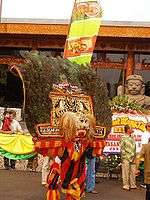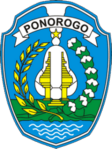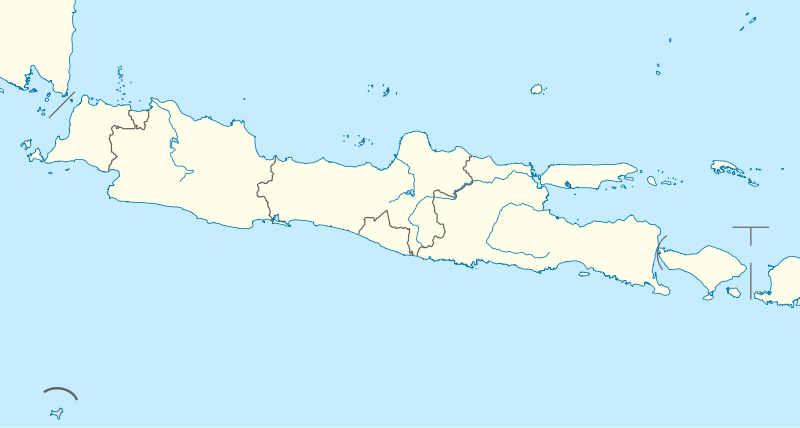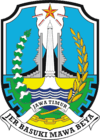Ponorogo Regency
Ponorogo (Indonesian: Kabupaten Ponorogo; Javanese: ꦑꦧꦸꦥꦠꦺꦤ꧀ꦦꦤꦫꦒ, romanized: Kabupatèn Pånårågå) is a regency (kabupaten) of East Java, Indonesia. It is considered the birthplace of Reog Ponorogo, a traditional Indonesian dance form. The Regency covers an area of 1,305.70 sq. km, and it had a population of 855,281 at the 2010 Census.[1] The latest official estimate (as at 2016) is 924,913.[2] The capital of the kabupaten is the local town of Ponorogo located around 30 km south of the main East Java city of Madiun.
Ponorogo Regency Kabupaten Ponorogo ꦑꦧꦸꦥꦠꦺꦤ꧀ꦦꦤꦫꦒ | |
|---|---|
 A demonstration of Reog Ponorogo. | |
 Seal | |
| Motto(s): Resik Endah Omber Girang Gemirang | |
 Location of Ponorogo Regency in East java | |
 Ponorogo Regency Location in Java | |
| Coordinates: 7°52′10″S 111°27′46″E | |
| Country | Indonesia |
| Province | East Java |
| Capital | Ponorogo (city) |
| Government | |
| • Regent | Drs. H. Ipong Muchlissoni |
| Area | |
| • Total | 1,305.70 km2 (504.13 sq mi) |
| Elevation | 100 m (300 ft) |
| Population (2016) | |
| • Total | 924,913 |
| • Density | 710/km2 (1,800/sq mi) |
| Demonyms | Ponorogonian Warga Ponorogo (id) Wong Ponorogo (jv) |
| Area code(s) | +62 352 |
| Website | ponorogo |
Geography
Ponorogo Regency is located in the southwestern part of the province of East Java on the border with Central Java province. It lies approximately 200 km south-west of Surabaya, the provincial capital of East Java. The regency lies between 92 and 2,563 meters above sea level and covers an area of about 1,305.7 km2.
History
According to the Babad Ponorogo history, Ponorogo was founded when Bathoro Katong conquered the Wengker region. This region had previously been controlled by Suryo Ngalam Wengker. Bathoro Katong originally settled in modern-day Pekalongan in what is now the village Setono in district Jenangan. Though faced with many obstacles, Raden Katong, Aji Selo, and Ki Ageng Mirah and his family continued to establish settlements in the region.
With the consent of all parties, Bathoro Katong established the Duchy Ponorogo on 11 August 1496.[3] This date is celebrated as the founding of Ponorogo, and is corroborated by ancient objects, such as a pair of stone gilang located in front of the fifth gate of the Katong Batara tomb complex. The gilang contains the forms of a human meditating, trees, eagle and elephants (candrasengkala gilang memet); all of which combine to represent the Saka year 1496.
Culture
Ponorogo, generally considered the birthplace of Reog, is also known by the names City (of) Reog and City (of) Rasta. Each year in the Islamic month of Muharram, Ponorogo holds a celebration known as Grebeg Suro, "the party of the people". Grebeg Suro involves many traditional events such as the National Reog Festival, the Heritage Carnival and the Larungan Proceedings of Prayer held at Lake Ngebel.
On 11 August, the anniversary of the founding of the Ponorogo Regency is celebrated. The day markes 11 August 1496, when Bathara Katong, the first leader of Ponorogo, went from the Old Town to the Central City of Ponorogo and crowned himself the first Duke of Ponorogo.
Ponorogo is also known for its culinary specialties such as Sate Ponorogo — grilled marinated chicken – served in peanut sauce, garnished with shredded shallots, chilli paste and lime juice.
Education
Educational institutions in Ponorogo range from pre-school and kindergarten to university.
Pre-school and kindergarten facilities are mainly provided private or religious institutions and are available in almost every village. Elementary schools are run by public and private institutions. There is at least one public elementary school in every village and some villages have more than one public elementary school.
There are a number of both junior and senior high schools in Ponorogo. High schools exist in every sub-district. In addition to senior high schools, students can study at vocational high schools. There are also many Islamic boarding schools. The most notable is the Pondok Modern Darussalam Gontor located in the village of Gontor in the Mlarak District.
Ponorogo also has several universities which are mostly run by private or religious institutions. There is one public university, the Ponorogo IAIN.
Sport and recreation
Telaga (lake) Ngebel covers approximately 150 hectares, and is popular for jet skiing and other water sports. The lake is roughly a one-hour drive (about 30 kilometers) from Ponorogo or Madiun.[4]
Recognition
In the Otonomy Awards 2011, Ponorogo Regency received the Grand Award of Public Service Innovation.[5]
Climate
Ponorogo has 65-95% of humidity. The maximum humidity is 95% and the average humidity is 80%. The wind velocity of Ponorogo is within the range of 0–7 km/hr. The maximum wind velocity is 7 km/hr and the average is 4 km/hr. The temperature of this City is within the range of 21.0 °C-33.3 °C with the average temperature is 27.2 °C.
| Month | 1 | 2 | 3 | 4 | 5 | 6 | 7 | 8 | 9 | 10 | 11 | 12 |
|---|---|---|---|---|---|---|---|---|---|---|---|---|
| Average Temperature (Celsius) | 27.4 | 26.4 | 27.4 | 27.1 | 26.2 | 26.7 | 26.6 | 27.4 | 27.7 | 28.4 | 27.5 | 27.0 |
| Min Temperature (Celsius) | 22.7 | 21.7 | 22.6 | 22.6 | 21.0 | 22.1 | 22.0 | 23.3 | 22.7 | 23.4 | 22.2 | 22.4 |
| Max Temperature (Celsius) | 32.1 | 31.1 | 32.2 | 31.6 | 31.3 | 31.3 | 31.2 | 31.5 | 32.7 | 33.3 | 32.7 | 31.5 |
References
- "Tabel Hasil Sensus Penduduk 2010 Provinsi JAWA TIMUR". Archived from the original on 28 October 2011. Retrieved 27 October 2019.
- "Buku Agregat Kependudukan Semester 1 2016" (PDF). Archived (PDF) from the original on 21 January 2019. Retrieved 21 January 2019.
- Philips, C.H., ed. (1951). Handbook of Oriental History. Royal Historical Society. p. 265. ASIN B0088L3G6I (UK).CS1 maint: extra text: authors list (link)
- "Telaga ngebel - Ponorogo". Retrieved 19 December 2013.
- "Archived copy" (PDF). Archived from the original (PDF) on 30 September 2011. Retrieved 15 July 2011.CS1 maint: archived copy as title (link)
External links
| Wikimedia Commons has media related to Ponorogo Regency. |
- (in Indonesian) Official website
